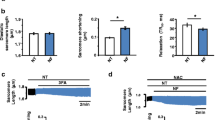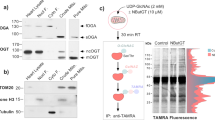Summary
In order to understand the role of carnitine metabolites in the genesis of cellular dysfunction and damage due to myocardial ischemia, the effects of 1–100 μM L-carnitine, acetylcarnitine, propionylcarnitine, and palmitoylcarnitine were investigated on rat heart sarcolemmal, sarcoplasmic reticular, and mitochondrial ATPase activities. Palmitoylcarnitine, unlike acetylcarnitine, propionylcarnitine and carnitine, produced marked inhibitory actions on sarcolemmal Na,K-ATPase and Ca2+-stimulated ATPase, as well as sarcoplasmic reticular Ca2+-stimulated ATPase activities; Na,K-ATPase was most sensitive. Although palmitoylcarnitine, unlike carnitine or its short-chain fatty-acid derivatives, also depressed sarcolemmal Ca2+ ATPase or Mg2+ ATPase, sarcoplasmic reticular Mg2+ ATPase, and mitochondrial Mg2+ ATPase, mitochondria were less sensitive in comparison to other organelles. Myofibrillar Ca2+-stimulated ATPase was slightly inhibited by very high concentrations of palmitoly-carnitine only. It is suggested that the observed depression of the sarcolemmal Na+-pump system by low concentrations of long-chain acyl derivatives of carnitine may contribute towards the pathogenesis of arrhythmias due to myocardial ischemia. Furthermore, the inhibition of Ca2+-pump mechanisms in the sarcolemmal and sarcoplasmic reticular membranes by relatively high concentrations of palmitoylcarnitine may result in the occurrence of intracellular Ca2+ overload and subsequent cell damage, as well as cardiac dysfunction due to myocardial ischemia.
Similar content being viewed by others
References
Fritz IB. Action of carnitine on long chain fatty acid oxidation by liver. Am J Physiol 1959;197:297–304.
Idell-Wenger JA, Grotyohann LW, Neely JR. Coenzyme A and carnitine distribution in normal and ischemic hearts. J Biol Chem 1978;253:4310–4318.
Feuvray D, Idell-Wenger JA, Neely JR. Effects of ischemia on rat myocardial function and metabolism in diabetes. Circ Res 1979;44:322–329.
Shug AL, Thomsen JH, Folts JD, et al. Changes in tissue levels of carnitine and other metabolites during myocardial ischemia and anoxia. Arch Biochem Biophys 1978;187:25–33.
Corr PB, Gross RW, Sobel BE. Amphipathic metabolites and membrane dysfunction in ischemic myocardium Circ Res 1984;55:135–154.
Opie LH. Role of carnitine in fatty acid metabolism of normal and ischemic myocardium. Am Heart J 1979;97: 375–388.
Hülsmann WC, Dubelaar ML, Lamers JMJ, Maccari F. Protection by acyl-carnitines and phenylmethylsulfonyl fluoride of rat heart subjected to ischemia and reperfusion. Biochim Biophys Acta 1985;847:62–66.
Paulson DJ, Schmidt MJ, Romens J, et al. Metabolic and physiological differences between zero-flow and low flow myocardial ischemia: Effects of L-acetylcarnitine. Basic Res Cardiol 1984;79:551–561.
Molaparast-Saless F, Nellis SH, Liedtke AJ. The effects of propionylcarnitine taurine on cardiac performance in aerobic and ischemic myocardium. J Mol Cell Cardiol 1988;20: 63–74.
Folts JD, Shug AL, Koke JR, et al. Protection of the ischemic dog myocardium with carnitine. Am J Cardiol 1978;41:1209–1214.
Liedtke AJ, Nellis SH. Effects of carnitine in ischemic and fatty acid supplemented swine hearts. J Clin Invest 1979;64:440–447.
Liedtke AJ, Nellis SH, Whitesell LF. Effects of carnitine isomers on fatty acid metabolism in ischemic swine hearts. Circ Res 1981;48:859–866.
Ferrari R, Cucchini F, Visioli O. The metabolical effects of L-carnitine in angina pectoris. Int J Cardiol 1984;5:213–216.
Thomsen JH, Shug AL, Yap VU, et al. Improved pacing tolerance of the ischemic human myocardium after administration of carnitine. Am J Cardiol 1979;43:300–306.
Tahiliani AG, McNeill JH. Effect of triiodothyronine and carnitine therapy on myocardial dysfunction in diabetic rats. Can J Physiol Pharmacol 1986;64:669–672.
Mathew S, Menon PVG, Kurup PA. Effect of administration of carnitine on the severity of myocardial infarction induced by isoproterenol in rats. Aust J Exp Biol Med Sci 1986; 64:79–87.
Whitmer JT. L-Carnitine treatment improves cardiac performance and restores high-energy phosphate pools in cardiomyopathic Syrian hamster. Circ Res 1987;61:396–408.
Katz AM, Messineo FC. Lipid-membrane interactions and the pathogenesis of ischemic damage in the myocardium. Circ Res 1981;48:1–16.
Knabb MT, Saffitz JE, Corr PB, Sobel BE. The dependence of electrophysiological derangements on accumulation of endogenous long-chain acyl carnitine in hypoxic neonatal rat myocytes. Circ Res 1986;58:230–240.
Lopaschuk GD, Katz S, McNeill JH. The effect of alloxanand streptozotocin-induced diabetes on calcium transport in rat cardiac sarcoplasmic reticulum. The possible involvement of long chain acylcarnitines. Can J Physiol Pharmacol 1983;61:439–448.
Wood JM, Bush B, Pitts BJR, et al. Inhibition of bovine heart Na+,K+-ATPase by palmitoylcarnitine and palmityl-CoA. Biochem Biophys Res Commun 1977;74:677–684.
Adams RJ, Pitts BJR, Wood JM, et al. Effect of palmitoyl-carnitine on ouabain binding to Na,K-ATPase. J Mol Cell Cardiol 1979;11:941–959.
Kramer JH, Weglicki WB. Inhibition of sarcolemmal Na+-K+-ATPase by palmitoyl carnitine: Potentiation by propranolol. Am J Physiol 1985;248:H75-H81.
Pitts BJR, Okhuysen CH. Effects of palmitoyl carnitine and LPC on cardiac sarcolemmal Na+-K+-ATPase. Am J Physiol 1984;247:H840-H846.
Adams RJ, Cohen DW, Gupte S, et al. In vitro effects of palmitoyl carnitine on cardiac plasma membrane Na, K-ATPase, and sarcoplasmic reticulum Ca2+-ATPase and Ca2+ transport. J Biol Chem 1979;254:12404–12410.
Inoue D, Pappano AJ. L-Palmitoylcarnitine and calcium ions act similarly in excitatory ionic currents in avian ventricular muscle. Circ Res 1983;52:625–634.
Wise BC, Kuo JF. Modes of inhibition by acylcarnitines, adriamycin and trifluoperazine of cardiac phospholipid-sensitive calcium dependent protein kinase. Biochem Pharmacol 1983;32:1259–1265.
Spedding M, Mir AK. Direct activation of Ca2+ channels by palmitoyl carnitine, a putative endogenous ligand. Br J Pharmacol 1987;92:457–468.
Pitts BJR. Stoichiometry of sodium-calcium exchange in cardiac sarcolemmal vesicles: Coupling to the sodium pump. J Biol Chem 1979;254:6232–6235, 1979.
Makino N, Dhalla KS, Elimban V, et al. Sarcolemmal Ca2+ transport in streptozotocin-induced diabetic cardiomyopathy in rats. Am J Physiol 1987;253:E202-E207.
Alto LE, Dhalla NS. Role of changes in microsomal calcium in the effects of reperfusion of Ca2+-deprived rat hearts. Circ Res 1981;48:17–24.
Sordahl LA, McCallum WB, Wood WG, et al. Mitochondria and sarcoplasmic reticulum functions in cardiac hypertrophy and failure. Am J Physiol 1973;224:497–502.
Solaro RJ, Pang DC, Briggs FN. The purification of cardiac myofibrils with Triton X-100. Biochim Biophys Acta 1971;245:259–262.
Dhalla NS, Anand-Srivastava MB, Tuana BS, et al. Solubilization of a Ca2+ dependent adenosine triphosphatase from rat heart sarcolemma. J Mol Cell Cardiol 1981;13:413–423.
Elimban V, Dhalla KS, Panagia V, et al. A biphasic change in contractile proteins during the development of cardiac hypertrophy in pigs. Basic Res Cardiol 1983;82:1–8.
Ferrari R, Ciampalini G, Agnoletti G, et al. Effect of L-carnitine derivatives on heart mitochondrial damage induced by lipid peroxidation. Pharmacol Res Commun 1988;20:125–132.
Dhalla NS, Pierce GN, Panagia V, et al. Calcium movements in relation to heart function. Basic Res Cardiol 1982;77:117–139.
Ashavaid TF, Colvin RA, Messineo FC, et al. Effects of fatty acids on Na/Ca exchange in cardiac sarcolemmal membranes. J Mol Cell Cardiol 1985;17:851–861.
Author information
Authors and Affiliations
Rights and permissions
About this article
Cite this article
Dhalla, N.S., Kolár, F., Shah, K.R. et al. Effects of some L-carnitine derivatives on heart membrane ATPases. Cardiovasc Drug Ther 5, 25–30 (1991). https://doi.org/10.1007/BF00128240
Issue Date:
DOI: https://doi.org/10.1007/BF00128240




